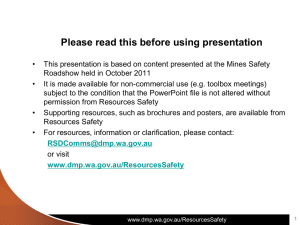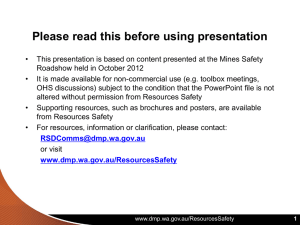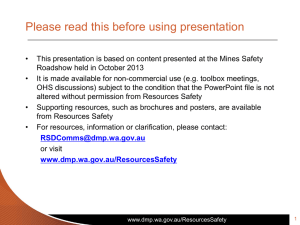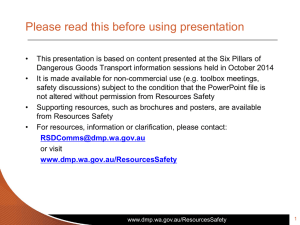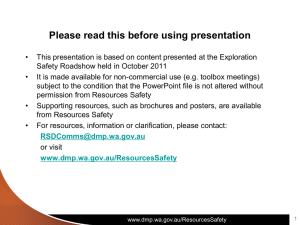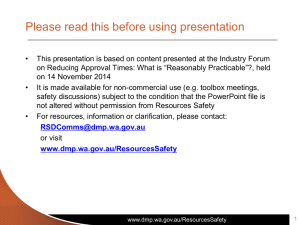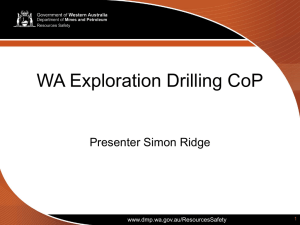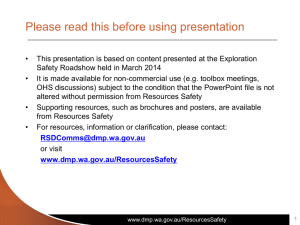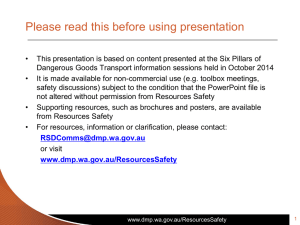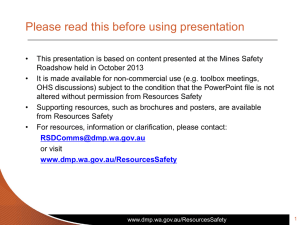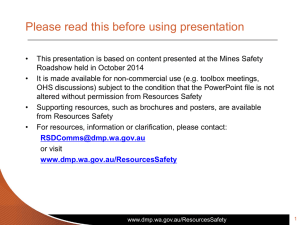MS - Toolbox presentation - Fatigue, shift structures and working hours
advertisement
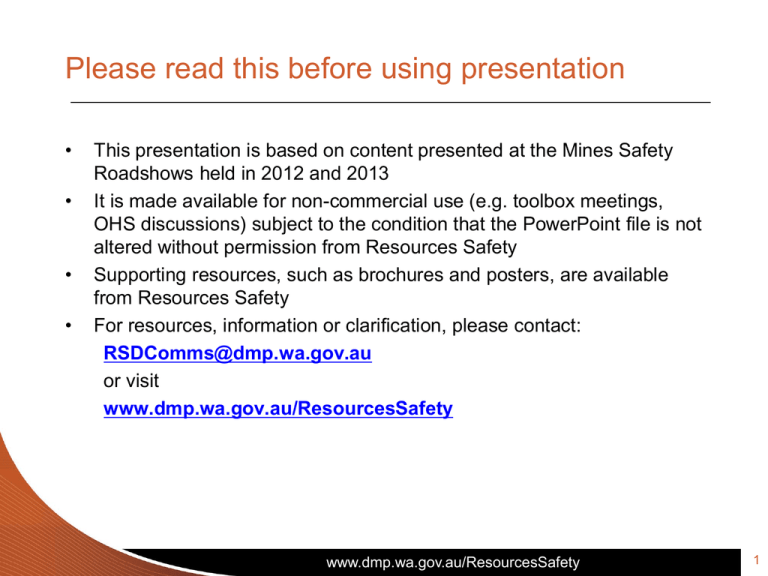
Please read this before using presentation • • • • This presentation is based on content presented at the Mines Safety Roadshows held in 2012 and 2013 It is made available for non-commercial use (e.g. toolbox meetings, OHS discussions) subject to the condition that the PowerPoint file is not altered without permission from Resources Safety Supporting resources, such as brochures and posters, are available from Resources Safety For resources, information or clarification, please contact: RSDComms@dmp.wa.gov.au or visit www.dmp.wa.gov.au/ResourcesSafety www.dmp.wa.gov.au/ResourcesSafety 1 Fatigue, shift structures and working hours www.dmp.wa.gov.au/ResourcesSafety 2 What are the top ten priority issues for 2013-14? Safety culture Risk management training Principal hazard management plans (PHMPs) Safety in design Maintenance Construction Management and supervision Safety and health representatives Fatigue prevention and management Exploration www.dmp.wa.gov.au/ResourcesSafety 3 Risk underestimated • Fatigue Reduced coordination • Affects safety performance Inattention Decreased awareness Absentmindedness • Hazard Slower reactions • Prevent and manage Reduced ability to process information Memory lapses www.dmp.wa.gov.au/ResourcesSafety 4 Why is addressing fatigue important? www.dmp.wa.gov.au/ResourcesSafety So what can we do about it? • Hazard – prevent, manage • Do not underestimate risks • Duty of care – employers – employees www.dmp.wa.gov.au/ResourcesSafety Which shift schedule is best? Diverse workplaces Diverse work Diverse people No single optimal shift system that suits everyone www.dmp.wa.gov.au/ResourcesSafety 7 What about scheduling? Shift duration Direction of shift rotation Shift timing Workload Optimal shift system for your workplace Number and length of breaks during and between shifts www.dmp.wa.gov.au/ResourcesSafety 8 What are some key management principles? • Consult employees on working hours and shift patterns • Develop a policy that specifically address risk factors and guards against fatigue (i.e. prevention rather than control) • Implement policy then monitor and enforce it • Review following assessment of: – adequacy of resourcing and staffing levels – effect of changes to working hours • Employer-provided accommodation – conducive to sleep during night and day www.dmp.wa.gov.au/ResourcesSafety What is consultation like at your workplace? Is the workforce (e.g. safety and health representatives) consulted when policies and procedures are: – being developed? – being reviewed and revised? Is the workforce consulted when there are changes to: – the workplace? – systems of work? www.dmp.wa.gov.au/ResourcesSafety How is your site doing? See page 2 of HSE Human Factors Briefing Note 10 www.dmp.wa.gov.au/ResourcesSafety Resources Safety’s current guidance used them? read them? Have you seen them? http://www.dmp.wa.gov.au/16259.aspx www.dmp.wa.gov.au/ResourcesSafety 12 Suite of resources www.dmp.wa.gov.au/ResourcesSafety 13 What other guidance is available? • UK-based Health and Safety Executive (HSE) and Energy Institute www.dmp.wa.gov.au/ResourcesSafety Fatigue prevention and management Affects all of us Involves all of us Unlike almost all other hazards at our workplace, is affected by external risk factors Is our fatigue management plan adequate? Are you fit for work? www.dmp.wa.gov.au/ResourcesSafety
